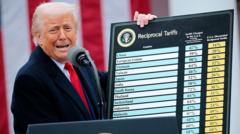**As Canada imposes a 25% tariff on U.S. auto imports, the government aims to cushion the economic impact on thousands of workers facing job losses due to these retaliatory measures.**
**Canada's Trade Retaliation: Billions for Workers Amidst Economic Turmoil**

**Canada's Trade Retaliation: Billions for Workers Amidst Economic Turmoil**
**In light of new tariffs, Canada commits billions to support affected workers and businesses, but challenges in implementation loom.**
As of April 9, 2025, Canada has implemented a substantial 25 percent tariff on cars and trucks imported from the United States, marking a significant retaliation against earlier tariffs imposed on Canadian exports by former President Trump. This newly enforced tariff is projected to generate approximately 8 billion Canadian dollars (roughly $5.7 billion) annually, with funds earmarked to assist Canadian workers and businesses grappling with economic challenges stemming from U.S. trade policies.
The new tariffs arrive as Canadian officials look to mitigate the impending impact from job losses, plant shutdowns, and increased bankruptcies within the automotive sector, which represents Canada’s largest export to the U.S. after energy. The swift repercussions of the tariff regime were palpable when Stellantis revealed that its assembly plant in Windsor, Ontario, would shut down for two weeks, thereby affecting thousands of jobs and halting operations due to uncertainty surrounding the tariffs.
Flavio Volpe, head of the Automotive Parts Manufacturers' Association of Canada, estimated that as many as 12,000 workers from parts plants in Canada and those controlled by Canadian entities in the U.S. have been put out of work following Stellantis’s decision to temporarily close its facility. Countries such as Spain and South Korea have also begun formulating their responses to the tariff situation, indicating that Canada’s challenges are mirrored globally.
Although the Canadian government endeavors to utilize tariff-generated funds to support industries and workers, the scope and structure of aid initiatives remain unclear amidst the economic disruptions. As the situation evolves, the Canadian government faces the critical task of navigating these retaliatory tariffs while ensuring economic stability for its workforce.























